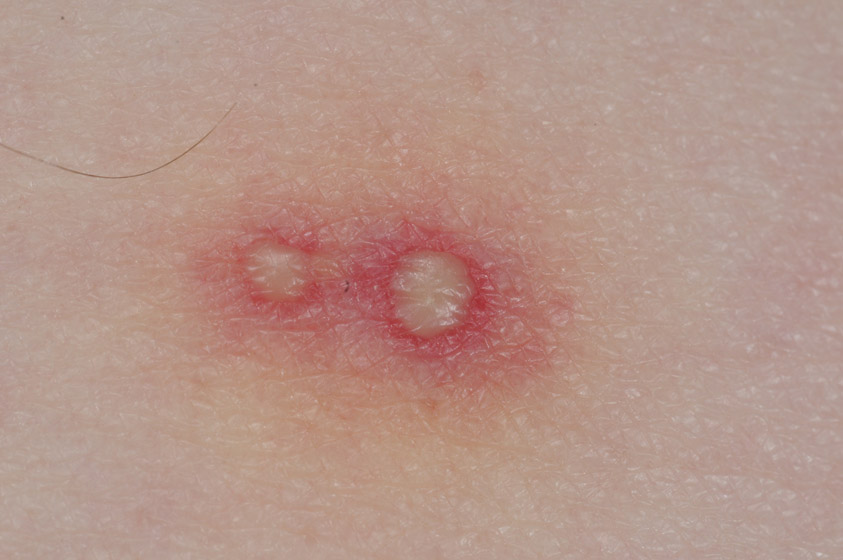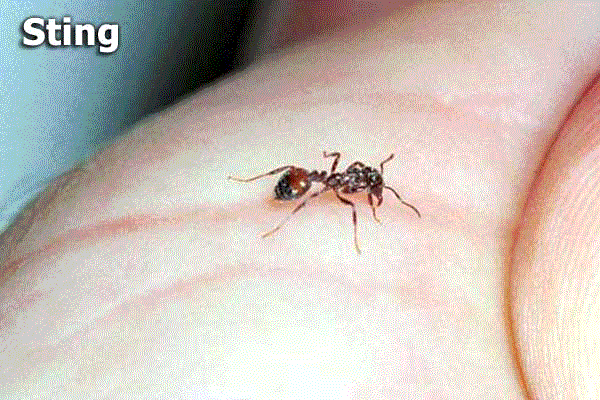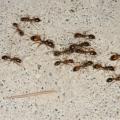The Fire Ant Sting

Anyone who has ever been unfortunate enough to have an intimate encounter with fire ants understands why they are such unwelcome pests. They sting and it hurts!
Fire ants bite as well, grasping the skin with their mandibles to anchor themselves and better insert their sting. The bite is of no lasting consequence, but the venom they inject through their sting is quite potent, especially in relation to their size. Unlike the sting of the honey bee, the sting of the fire ant is not barbed, and an individual worker can sting repeatedly and still survive to return to her normal duties.
Initially, there is a sharp localized pain. Within about 24 hours a raised white pustule forms at the site, and this will persist for many days. Despite the appearance of this pustule, it is not infected. Stings can cause localized pain and/or itching for several days, and they can potentially become infected, especially if broken open by scratching or other causes. The potential for secondary problems is greater in people suffering from medical problems, such as diabetes or compromised immune systems.
For most people a single fire ant sting is a ‘mildly painful’ experience that would quickly be forgotten were it not for the ‘mildly irritating’ pustule. Unfortunately, a stinging encounter with fire ants usually involves more than one ant, and each year many people have the experience of being stung by dozens, or even hundreds, of fire ants. The pain and irritation associated with a single sting is multiplied many fold in such incidents. Most people recover from such encounters with no lasting ill effects, and it is only when such stinging incidents involve many hundreds or thousands of stings that they become truly threatening. But incidents of this magnitude do occasionally occur, usually involving people who are less mobile due to age, accident or infirmity.
Although a few fire ant stings do not constitute a medical emergency for most people, a very small percent of people develop allergic reactions to fire ant venom. These vary in intensity, but in the most extreme cases even a few stings can result in the life-threatening condition known as anaphylaxis. Each year there are cases of human fatalities resulting from fire ant stings, either due to anaphylaxis or to massive numbers of stings occurring on people who are incapacitated.
Given the pain and discomfort that can result from even a few fire ant stings, it is fortunate that fire ants do not normally aggressively seek out and attack human beings. The vast majority of stinging events occur when people inadvertently ‘attack’ the fire ants, usually by unknowingly stepping in, lying in, or otherwise disturbing the mound. The ants perceive this disturbance as a direct attack and the workers quickly react en masse to defend their colony.
Lesion Development:

Mississippi State University Extension.
Images linked below are used in the animated photos of a person's finger after a fire ant sting:
- Stinging photo: A worker female fire ant in the act of stinging a human thumb.
- 30 minute photo: There is a slight swollen bump where each sting occurred, surrounded by redness.
- One hour photo: The bumps persist, and the surrounding redness gets deeper red.
- 24 hours photo: A pustule is now present where each sting occurred. Lesions are still surrounded by a deep red halo.
- 72 hours photo: Pustules are at their peak, with a deep red halo, and some tissue death inside the tiny pustule domes.
- One week photo: By now the pustules have ulcerated; the red halo persists.
- One month: Only superficial scars remain where the stings occurred.
Contact information for Dr. Blake Layton.
Publications
News
Sunshine and long days make summertime in the South desirable for people, but those same conditions are exactly what allows the dreaded, imported fire ants to thrive.
Almost any sunny, grassy area left unattended will soon be home to fire ants. Fire ants were accidentally imported from South America to Mobile in the 1930s and have since spread throughout the Southeast.
Everyone loves a good myth buster, and we have a very timely one for you! Fire ant beds in your yard can be such a headache to deal with. Many people have used home remedies to control ants. But are those quick fixes really getting rid of the ants in your yard? Let’s take a look at some commonly used home remedies and whether or not they work!
Do you have fire ants in your vegetable garden? Me too. Good news for all of us! There are some fire ant baits that are safe to use around food plants.



